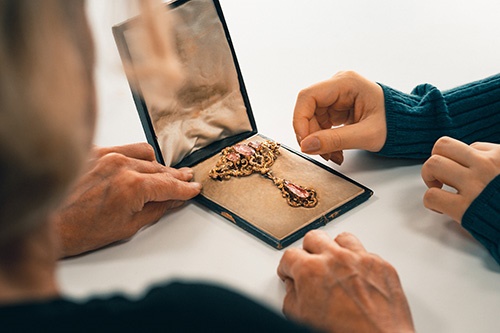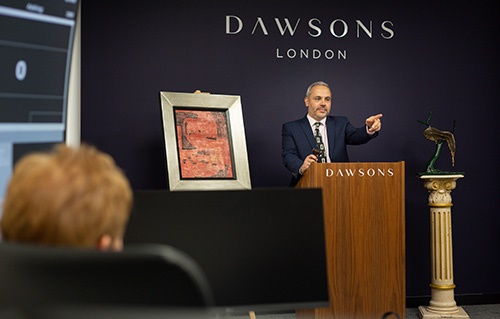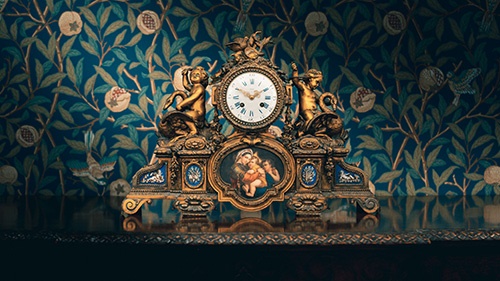Auction Estimates Explained
Everything you should know about auction estimates
24/02/2023
What is an auction estimate?
Auction estimates are an important aspect of the art world. They provide a prediction of how much an item will sell for at auction, which helps both buyers and sellers prepare for the sale. An estimate is typically determined by the auction house or auctioneer and is based on their knowledge of the market, the item's historical significance, it's condition, previous auction prices achieved for a similar items, and other factors such as rarity.
The estimate is usually expressed as a range, with a low and high estimate. The low estimate is the minimum amount that the auction house expects the item to sell for, while the high estimate is the maximum amount. The actual sale price may fall within or outside this range, depending on the demand for the item and the bidding activity during the auction.
Auction estimates can be important for both the buyer and the seller. For buyers, the estimate provides an idea of the expected value of the item and can help them determine how much they are willing to bid. For sellers, the estimate can help them set a reserve price, which is the minimum amount they are willing to accept for the item.

How are estimates calculated?
Whilst auction estimates may appear to be rough approximations, they are actually more complex to configure than they may seem. Indeed, there are considerable risks that come with offering an estimate that is the slightest bit too high or low.
Expert knowledge
Auction estimates are negotiated and agreed between a valuation specialist and a vendor. It is important to trust the judgement of the expert valuer as they not only have knowledge of the market, but also the auction world. Auctions are far more complicated than single buyer sales because the final value (hammer price) is ultimately dictated by the bidders and how much they are willing to pay for an item.

Expert knowledge is crucial when obtaining an auction estimate:
- Accuracy: Expert valuers have specialist knowledge and experience in assessing the value of items being sold at auction. They can provide a more accurate estimate of an item's worth based on factors such as rarity, condition, provenance, and current market trends. Without expert knowledge, the estimate may be inaccurate, which could result in an item being sold for far less than it's true worth.
- Credibility: Auction estimates provided by expert valuers carry more weight and credibility than those provided by individuals without specialist knowledge. Potential bidders are more likely to trust and rely on estimates provided by reputable experts, which can lead to higher bids and a better outcome for the seller.
- Market Insights: Experts have a deep understanding of the current market and can provide insights into what buyers are currently looking for and willing to pay for. This can help sellers make informed decisions about when to sell their items, which auction houses to use, and how to price their items to attract a higher number of potential buyers.
- Competitive Advantage: Auction estimates provided by expert valuers can give sellers a competitive advantage over sellers who may not have access to the same level of knowledge or resources. With an expert's estimate, sellers can be more confident in their pricing strategy, which can help them attract more buyers and secure a higher sale price.
In summary, without expert knowledge, sellers may undervalue / overvalue their items, struggle to attract interest, fail to interest potential buyers, or ultimately not achieve the true value of the item(s) they are looking to sell.

Tactful starting bids
It can be difficult to understand the rationale behind the low estimate if you are the vendor, as the act of beginning by asking for bids below the item’s value is counterintuitive. However, experienced valuers will often advise that the low estimate is placed below the item’s market value, to encourage more bidders, and to give them the opportunity to ease into bidding and gradually work their way up towards the item’s value. It is important to note that strong bidding will only take place when there are multiple bidders, which then creates a competitive bidding environment that will ultimately end with a far higher sale price (hammer) for the vendor.
Auction day can be exhilarating, especially when bidding gets fiercely competitive and the price of an item starts to climb. Such an atmosphere can only be created when estimates are expertly calculated to encourage multiple bidders to take note of an item that is going under the hammer at auction. Bidding is a gradual process, and when managed correctly, a good auctioneer can secure the best price for an item on the day.

Provenance
Provenance refers to the origin or history of an object. It involves tracing the ownership, custody, and location of an item from its creation to its current state. Provenance provides important context and information about the authenticity of an item. This plays an important part in the process of providing an auction estimate, and whilst ownership alone doesn’t necessarily add value, provenance is a helpful indicator of the level of price that it can be expected to fetch at auction. For example, if an oil painting by a renowned artist was originally bought or gifted directly from that painter and passed down through a family over generations, the item will most likely sell well due to its rarity and the fact that it has never been on the market before.
In specific circumstances, relevant ownership, such as historically important letters written by a public figure, could add value to an item and therefore would also be considered in the auction estimate given.

Condition
The condition of an item is one of the most important factors in determining its value, as it affects its desirability, and overall appeal to potential buyers. An item that is in excellent condition is likely to attract more interest from buyers and command a higher price than a similar item in poor condition.

Previous sale results
Auction estimates take previous sale results for similr item's into account in order to provide an accurate assessment of an item's value. Ignoring current market trends can lead to overestimating or underestimating an item's value, which can have serious consequences for both buyers and sellers. In order to stay up-to-date on current market trends, our specialists use dedicated price databases to allow them to analyse past and current market activity and identify any trends or patterns that might affect how your item will perform at auction.
As an auction house, this is a vital part of the service we provide. As professionals, we strive to provide our clients with well-informed and realistic auction estimates, to ensure the best possible outcomes are achieved for them at auction.
Do you have any Art, Antiques, or Jewellery that you are looking to sell at auction?
The team of experts at Dawsons are always happy to provide a free appraisal in person at our saleroom in Berkshire, our valuation office in London, from the comfort of your own home via a home visit, or via our online valuation service.
Please do get in touch, we would love to hear from you.
0207 431 9445 info@DawsonsAuctions.co.uk